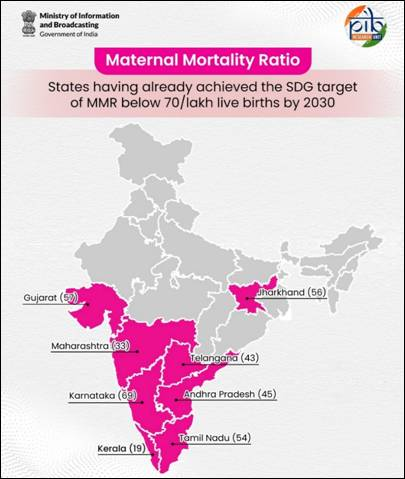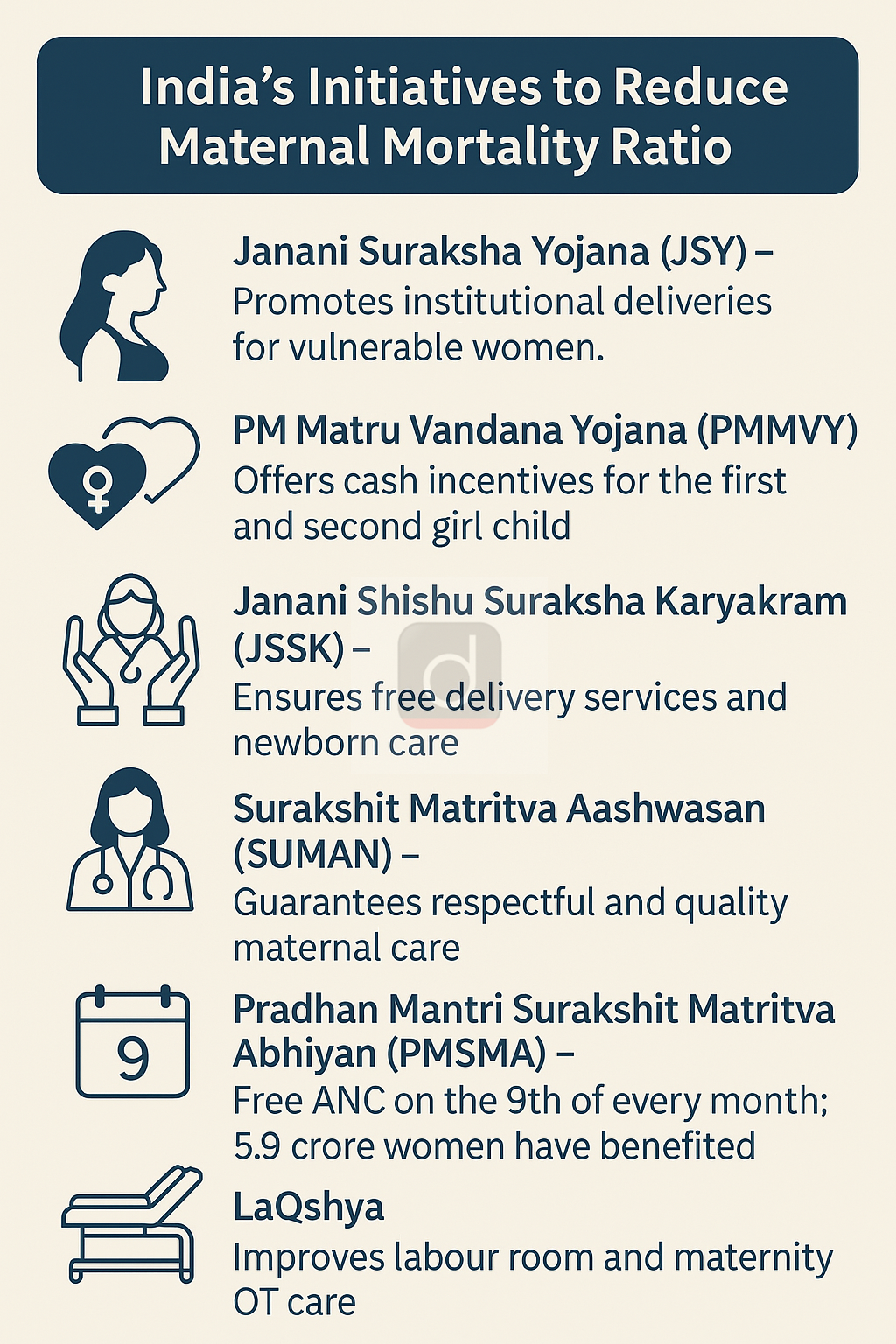Social Justice
Trends in Maternal Mortality
- 10 Apr 2025
- 7 min read
For Prelims: World Health Organization, Maternal Mortality Ratio, SDG Target 3.1, Health and Wellness Centers
For Mains: Maternal Health and Public Healthcare in India, Regional health disparities in India
Why in News?
A report by the United Nations Maternal Mortality Estimation Inter-Agency Group (MMEIG), titled “Trends in Maternal Mortality: 2000–2023”, has flagged India as the second-largest contributor to global maternal deaths after Nigeria.
Note: MMEIG is a group comprising the World Health Organization (WHO), the United Nations Children’s Fund (UNICEF), the United Nations Population Fund (UNFPA), the World Bank Group, United Nations Department of Economic and Social Affairs, Population Division.
What are the Trends in Maternal Mortality?
- India: In 2023, India recorded 19,000 maternal deaths, accounting for 7.2% of global maternal mortality, making it the 2nd largest contributor.
- India was followed by the Democratic Republic of Congo, also at 7.2%, and Pakistan at 4.1%.
- Despite this, India has made strong progress, with the Maternal Mortality Ratio (MMR) falling from 384 in 2000 to 103 in 2020, and further down to 80 in 2023, an 86% drop since 1990, surpassing the global average decline of 48%.
- Global MMR: From an estimated 443,000 deaths in 2000 to 260,000 in 2023, the global MMR declined from 328 to 197 per 100,000 live births, a 40% reduction.
- Sub-Saharan Africa accounted for 70% of maternal deaths with the highest regional MMR at 454.
- Oceania and Central & Southern Asia also reported moderate MMRs of 173 and 112, respectively.
- Only Australia and New Zealand had a very low MMR (~3), demonstrating stark inequalities.
- Slowing Progress: Annual rate of reduction (ARR) of global MMR dropped from 2.2% (2000–2023) to just 1.6% (2016–2023).
- Achieving Sustainable Development Goal (SDG) Target 3.1 (reducing global MMR to below 70 per lakh live births by 2030) requires an ARR of 14.8% from 2024 to 2030.
Maternal Death and MMR
- Maternal Death: Death of a woman during pregnancy or within 42 days of its end, due to pregnancy-related causes (excluding accidental/incidental causes).
- MMR: It is the number of maternal deaths per 100,000 live births in a given time period.
- It is a key indicator used to assess the quality of maternal healthcare and access to medical services during pregnancy and childbirth.
What are the Concerns Regarding India’s Maternal Mortality Progress?
- High Absolute Number of Maternal Deaths: Despite reducing its MMR to 80 per 100,000 live births, India still accounted for 7.2% of global maternal deaths, indicating persistent gaps in maternal healthcare access and quality.
- Unfair Comparisons in Global Reports: The Ministry of Health and Family Welfare flagged concerns over comparing India (145 crore) with Nigeria (23.26 crore) on maternal deaths, stating that using absolute numbers without adjusting for population size can misrepresent India’s relative progress.
- Slowing Pace of Progress: India’s MMR declined at 6.36% (2000–2020), higher than the global AAR of 2.07%, yet it is not fast enough to meet the SDG 3.1 target.
- While states like Kerala, Maharashtra, and Tamil Nadu have achieved an MMR below 70, others, such as Assam (195), Madhya Pradesh (173), Uttar Pradesh (167), and Bihar (118), lag behind the national average, reflecting regional disparities. in maternal healthcare.
- Challenges in Accessing Skilled Birth Care: Despite initiatives like the National Health Mission (NHM) and Janani Suraksha Yojana (JSY) , less institutional delivery in rural areas remains a concern due to lack of access to skilled birth attendants and emergency obstetric care.
- Complications such as postpartum hemorrhage, infections, and hypertensive disorders, which require timely medical intervention, remain leading causes of maternal deaths in these underserved areas.
- Non-Communicable Diseases (NCDs): India is also seeing an increasing number of indirect maternal deaths, especially due to NCDs like diabetes and hypertension .
- The growing burden of these diseases, coupled with inadequate prenatal care, is leading to higher maternal mortality .
How India Can Accelerate Progress Towards Reducing Maternal Mortality Rate?
- Strengthen Primary Health Care (PHC): Focus on Health and Wellness Centers (HWCs) to ensure women in rural and underserved areas access quality maternal care.
- Focus on Vulnerable Regions: Increase healthcare investments in high-risk states like Uttar Pradesh, Bihar, and Madhya Pradesh by leveraging mobile health units, telemedicine, and Accredited Social Health Activists can bridge access gaps.
- Additionally, targeted programs like Pradhan Mantri Surakshit Matritva Abhiyan (PMSMA) should be expanded to provide focused care for adolescent girls, tribal populations, and low-income groups.
- Policy Integration: Maternal health policies should be aligned with SDG 5 (Gender Equality) and SDG 10 (Reduced Inequalities) to ensure that maternal care is accessible to all women, especially marginalized groups.
- A multisectoral approach is essential to improve ma, educate communities, and address social determinants like poverty and gender-based violence.
- Enhance Data Systems: Promote accurate date collection under Civil Registration System (CRS) portal to ensure accurate reporting of maternal deaths, essential for effective policymaking and resource allocation.
- Leverage digital platforms like U-WIN under the Universal Immunization Programme for real-time tracking of maternal and child health indicators to enable targeted interventions.
|
Drishti Mains Question: Despite progress, India remains among the top contributors to global maternal mortality. Critically analyze the reasons and suggest measures to meet the SDG 3.1 target by 2030. |
UPSC Civil Services Examination, Previous Year Question (PYQ)
Mains
Q. In order to enhance the prospects of social development, sound and adequate health care policies are needed particularly in the fields of geriatric and maternal health care. Discuss. (2020)






